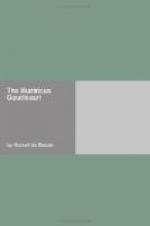When Madame Vernier heard the name of the lunatic she raised her head and looked at her husband.
“Ah, precisely; my wife intends to call on Madame Margaritis with one of our neighbors. Wait a moment, and you can accompany these ladies —You can pick up Madame Fontanieu on your way,” said the wily dyer, winking at his wife.
To pick out the greatest gossip, the sharpest tongue, the most inveterate cackler of the neighborhood! It meant that Madame Vernier was to take a witness to the scene between the traveller and the lunatic which should keep the town in laughter for a month. Monsieur and Madame Vernier played their part so well that Gaudissart had no suspicions, and straightway fell into the trap. He gallantly offered his arm to Madame Vernier, and believed that he made, as they went along, the conquest of both ladies, for those benefit he sparkled with wit and humor and undetected puns.
The house of the pretended banker stood at the entrance to the Valley Coquette. The place, called La Fuye, had nothing remarkable about it. On the ground floor was a large wainscoted salon, on either side of which opened the bedroom of the good-man and that of his wife. The salon was entered from an ante-chamber, which served as the dining-room and communicated with the kitchen. This lower door, which was wholly without the external charm usually seen even in the humblest dwellings in Touraine, was covered by a mansard story, reached by a stairway built on the outside of the house against the gable end and protected by a shed-roof. A little garden, full of marigolds, syringas, and elder-bushes, separated the house from the fields; and all around the courtyard were detached buildings which were used in the vintage season for the various processes of making wine.
CHAPTER IV
Margaritis was seated in an arm-chair covered with yellow Utrecht velvet, near the window of the salon, and he did not stir as the two ladies entered with Gaudissart. His thoughts were running on the casks of wine. He was a spare man, and his bald head, garnished with a few spare locks at the back of it, was pear-shaped in conformation. His sunken eyes, overtopped by heavy black brows and surrounded by discolored circles, his nose, thin and sharp like the blade of a knife, the strongly marked jawbone, the hollow cheeks, and the oblong tendency of all these lines, together with his unnaturally long and flat chin, contributed to give a peculiar expression to his countenance,—something between that of a retired professor of rhetoric and a rag-picker.




